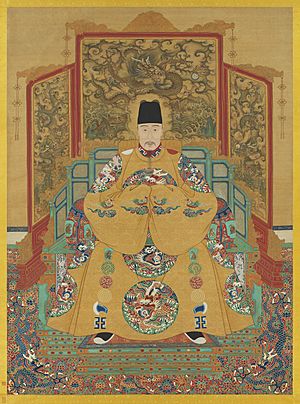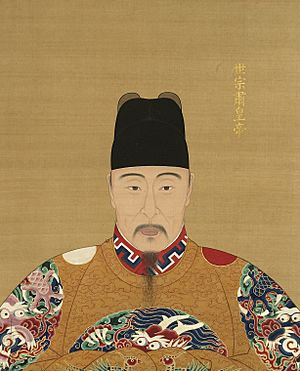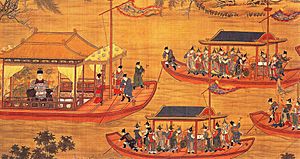Jiajing Emperor facts for kids
Quick facts for kids Jiajing Emperor嘉靖帝 |
|||||||||||||||||
|---|---|---|---|---|---|---|---|---|---|---|---|---|---|---|---|---|---|

|
|||||||||||||||||
| 12th Emperor of the Ming dynasty | |||||||||||||||||
| Reign | 27 May 1521 – 23 January 1567 | ||||||||||||||||
| Enthronement | 27 May 1521 | ||||||||||||||||
| Predecessor | Zhengde Emperor | ||||||||||||||||
| Successor | Longqing Emperor | ||||||||||||||||
| Prince of Xing (興王) | |||||||||||||||||
| Tenure | 15 April 1521 – 27 May 1521 | ||||||||||||||||
| Predecessor | Zhu Youyuan, Prince Xian | ||||||||||||||||
| Successor | Crowned as the emperor | ||||||||||||||||
| Born | 16 September 1507 Zhengde 2, 10th day of the 8th month (正德二年八月初十日) Anluzhou, Huguang Province |
||||||||||||||||
| Died | 23 January 1567 (aged 59) Jiajing 45, 14th day of the 12th month (嘉靖四十五年十二月十四日) Palace of Heavenly Purity, Forbidden City |
||||||||||||||||
| Burial | Yongling Mausoleum, Ming tombs, Beijing | ||||||||||||||||
| Consorts |
Empress Xiaojiesu
(m. 1522; died 1528)Empress Zhang
(m. 1522; dep. 1534)Empress Xiaolie
(m. 1530; died 1547)Empress Xiaoke
(m. 1530; died 1554) |
||||||||||||||||
| Issue |
|
||||||||||||||||
|
|||||||||||||||||
| House | House of Zhu | ||||||||||||||||
| Dynasty | Ming dynasty | ||||||||||||||||
| Father | Zhu Youyuan | ||||||||||||||||
| Mother | Empress Cixiaoxian | ||||||||||||||||
The Jiajing Emperor (Chinese: 嘉靖帝; pinyin: Jiājìng Dì; Wade–Giles: Chia-ching Ti) was the 12th Emperor of the Ming dynasty. He ruled from 1521 to 1567. Born Zhu Houcong, he was the cousin of the previous emperor, Zhengde Emperor. His father, Zhu Youyuan, was a prince and the fourth son of the Chenghua Emperor. The Jiajing Emperor's special name for his reign, "Jiajing", means "admirable tranquility".
Contents
Becoming Emperor: His Early Years
Zhu Houcong was not expected to become emperor. He was born as the son of a prince, not directly in line for the throne. However, in 1521, the Zhengde Emperor died suddenly. He had no children to take his place. This meant the throne was empty.
At just 13 years old, Zhu Houcong was chosen to be the next emperor. He moved from his home in Zhongxiang, Hubei, to the capital city, Beijing. As the new Jiajing Emperor, he honored his parents by giving them important imperial titles. He also built a grand tomb for them called the Xianling Mausoleum.
His Time as Emperor
When a new emperor was not the direct son of the previous one, it was tradition for him to be adopted by the former emperor. This was to keep the royal family line unbroken. However, Jiajing did not want to be adopted by the Hongzhi Emperor. He wanted his own father to be declared an emperor after his death. This disagreement became known as the "Great Rites Controversy."
The Jiajing Emperor won this argument. Many officials who disagreed with him were punished or even removed from their jobs. He was known for being smart and good at managing government papers. However, he often chose not to attend important meetings with his officials.
Ruling Style and Challenges
The Jiajing Emperor was sometimes seen as harsh. He preferred to live outside the Forbidden City in Beijing, away from others. He let trusted officials like Zhang Cong and Yan Song handle many government tasks. Over time, Yan Song and his son became very powerful. They were even called the "First and Second Prime Minister."
Some brave officials, like Hai Rui, tried to tell the emperor about problems or corruption. But the emperor often ignored them. From 1539 onwards, the Jiajing Emperor stopped meeting with his officials almost entirely. For about 25 years, he communicated only through his trusted helpers. This led to more corruption in the government. Even so, the emperor was clever enough to keep control of his court.
During his reign, China faced challenges. In 1542, a Mongol leader named Altan Khan started attacking China's northern border. In 1550, he even reached the areas near Beijing. To stop the attacks, the Ming government eventually gave the Mongols special trading rights. The government also had to fight against pirates who attacked the southeastern coast. In 1550, Beijing's outer city walls were also made larger.
Interest in Taoism
The Jiajing Emperor was very interested in Taoism, a traditional Chinese philosophy and religion. He tried to reduce the influence of Buddhism. After an incident in 1542, the emperor moved out of the main imperial palace. He then spent a lot of time on his Taoist practices, sometimes ignoring his duties as emperor.
He built three Taoist temples: the Temple of the Sun, the Temple of the Earth, and the Temple of the Moon. He also made the Temple of Heaven bigger. Over the years, his focus on Taoism became very expensive for the government. He also spent a lot of time trying to find special medicines to live longer. He used Taoist priests to gather rare minerals for these "elixirs," which sometimes contained harmful substances.
His Legacy and Death
The Jiajing Emperor ruled for 45 years, which was the second longest reign in the Ming dynasty. He died in 1567 and his son, the Longqing Emperor, became the next ruler.
While his long rule brought some stability, the emperor's habit of not attending to his duties led to problems for the dynasty later on. His way of governing, or rather not governing, was later copied by his grandson, the Wanli Emperor.
The Jiajing Emperor died in December 1566 but was buried three months later. Some historians think they might have been waiting for a special copy of the Yongle Encyclopedia to be finished before his burial.
Portrayal in Art
The Jiajing Emperor was shown in many paintings from his time. For example, in a large painting below, he can be seen riding a black horse and wearing a special helmet. He stands out from his bodyguards because he is shown as being very tall.
Family
The Jiajing Emperor had several wives and many children. His main wives included:
- Empress Xiaojiesu
- Empress Zhang
- Empress Xiaolie
- Empress Xiaoke (mother of the next emperor)
His children included:
- Zhu Zaiji, Crown Prince Aichong (his first son)
- Zhu Zairui, Crown Prince Zhuangjing (his second son)
- Longqing Emperor (his third son, who became the next emperor)
- Several other sons and daughters.
See also
 In Spanish: Jiajing para niños
In Spanish: Jiajing para niños
- Chinese emperors family tree (late)






